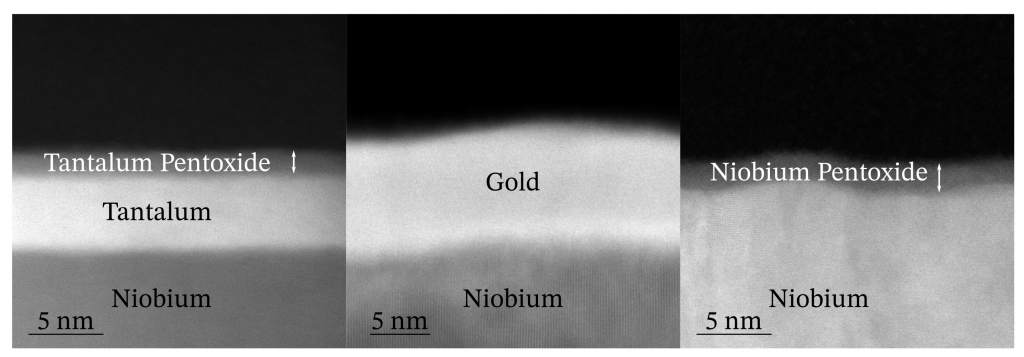SQMS scientists develop unique qubit fabrication techniques that enable systematic improvements in the performance of superconducting devices for quantum computing, communication, and sensing
The Science: Previous studies have demonstrated that the niobium surface oxide serves as the major factor limiting coherence times of niobium superconducting qubits. By encapsulating niobium qubit devices with materials such as tantalum, gold, titanium nitride, and aluminum, we are able to systematically increase T1 relaxation times by 2 to 5x compared to samples prepared without a capping layer (containing the niobium oxide layer). Tantalum and gold proved to be the most effective capping layers for enabling a higher coherence time, with an average of 0.3 milliseconds and maximum values as high as 0.6 milliseconds. These values represent some of the highest lifetimes to date for superconducting qubits prepared on both sapphire and silicon.

The Impact: As this surface encapsulation strategy is scalable and viable in industrial cleanrooms, this innovation can be directly implemented to improve the performance of mid-scale quantum processor prototypes. SQMS researchers from Fermilab and Rigetti have co-developed a 9-qubit transmon qubit chip-based processor incorporating these advances. Similarly, Fermilab scientists have been working to integrate these qubits with superconducting radio-frequency (SRF) cavities to advance the performance of 3D cavity-based quantum processor architectures.
Summary: We present a transmon qubit fabrication technique that yields systematic improvements in T1 relaxation times. This technique involves encapsulating the surface of niobium and preventing the formation of its lossy surface oxide. By maintaining the same superconducting metal and only varying the surface, this comparative investigation examining different capping materials, such as tantalum, aluminum, titanium nitride, and gold, as well as substrates across different qubit foundries demonstrates the detrimental impact that niobium oxides have on coherence times of superconducting qubits, compared to native oxides of tantalum, aluminum or titanium nitride. Our surface-encapsulated niobium qubit devices exhibit T1 relaxation times 2–5 times longer than baseline qubit devices with native niobium oxides. When capping niobium with tantalum, we obtain median qubit lifetimes above 0.3 ms, with maximum values up to 0.6 ms. Our comparative structural and chemical analysis provides insight into why amorphous niobium oxides may induce higher losses compared to other amorphous oxides.
Contact: Akshay Murthy – amurthy@fnal.gov
Focus Areas: Materials, Devices
Institutions: Fermilab, Rigetti Computing, Northwestern University, Ames National Laboratory, NIST Boulder, Louisiana State University
Citation: Bal, M. et al., Systematic Improvements in Transmon Qubit Coherence Enabled by Niobium Surface Encapsulation. npj Quantum Inf 10, 43 (2024).
Funding Acknowledgement: This material is based upon work supported by the U.S. Department of Energy, Office of Science, National Quantum Information Science Research Centers, Superconducting Quantum Materials and Systems Center (SQMS) under contract no. DE-AC02-07CH11359. This work made use of the Pritzker Nanofabrication Facility of the Institute for Molecular Engineering at the University of Chicago, which receives support from Soft and Hybrid Nanotechnology Experimental (SHyNE) Resource (NSF ECCS-2025633), a node of the National Science Foundation’s National Nanotechnology Coordinated Infrastructure.
Related links: Researchers at the SQMS Center achieve leading performance in transmon qubits